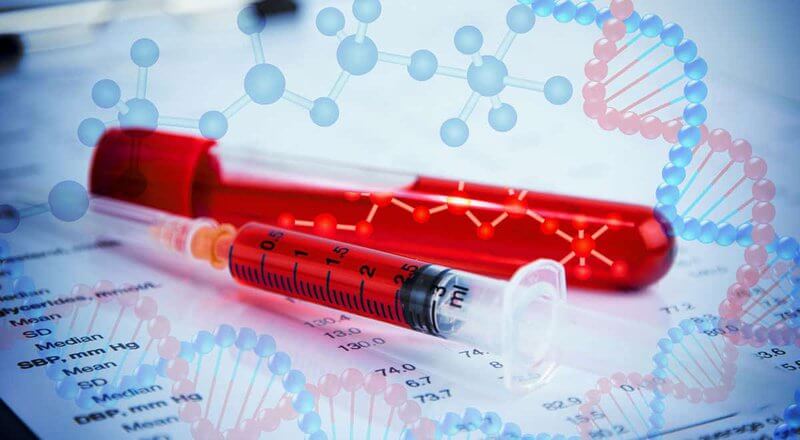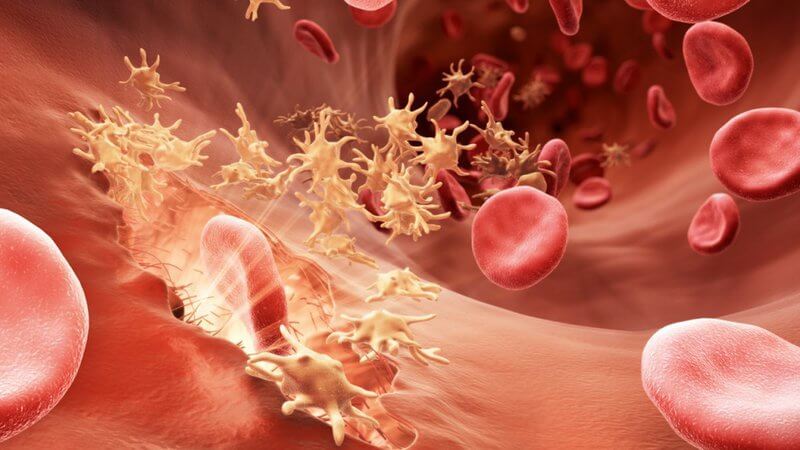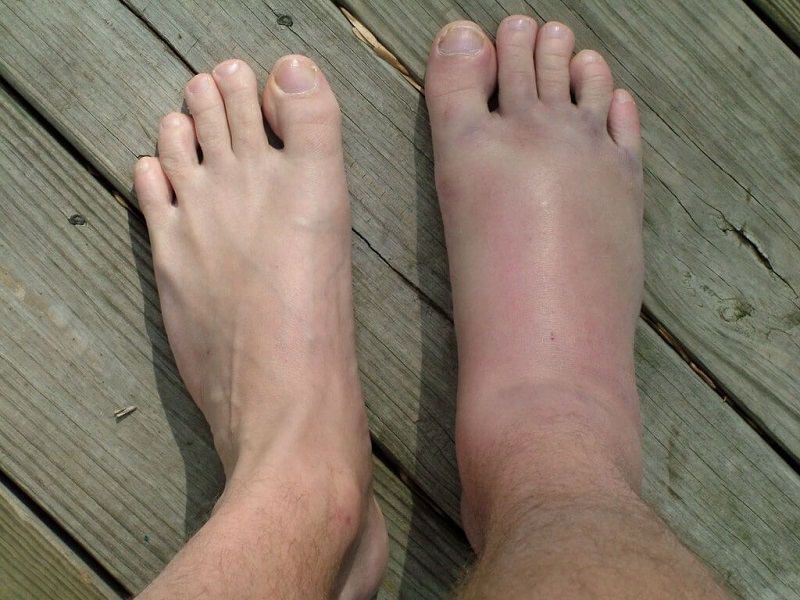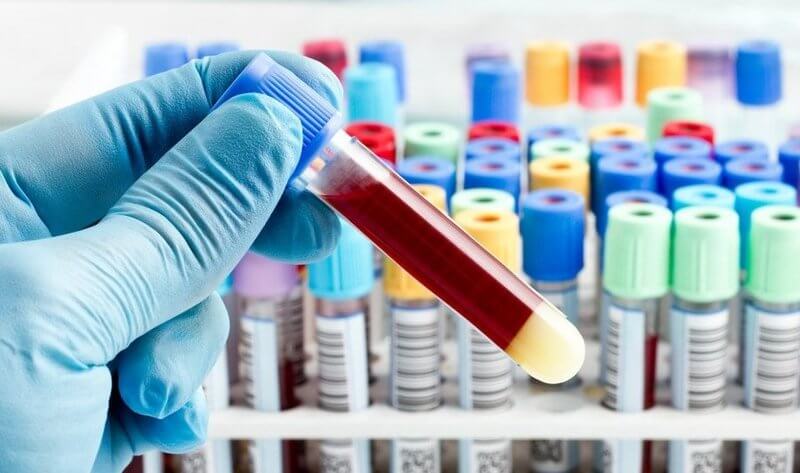Blood clotting has a very important meaning for human health. Thanks to the blood clotting mechanism, it will help stop the bleeding.
However, coagulation and anti-coagulation factors that occur if not detected early and treated promptly will cause danger to the patient. Understanding the clotting mechanism and symptoms of blood clotting will give the patient a chance to reduce the risks posed by the disease.

What Is Blood Clotting?
Coagulation is a complex process that results in a blood clot appearing. Blood clots have 2 important components: platelets and blood fibers. When the body is injured, damaging the endothelium of blood vessels, the clotting reaction is immediately activated.
The blood clot is responsible for covering the wound, the platelets create the initial stopper to stop bleeding, limit blood loss. At the same time, secondary coagulation also takes place in a chain reaction to form blood fibers that reinforce the platelet stopper.
When a person has a blood clotting disorder, also known as an inherited blood clotting disorder, the blood does not clot as it should.
Currently, blood clotting is a rare form of the disease. There are two types of coagulation most common: inherited blood clotting disorder A (due to lack of factor VIII) and genetic clotting disorder B (due to lack of factor IX).
If you have a family member who has a blood clotting disease, you also have a higher risk of blood clotting than usual because blood clotting has a genetic factor.
According to statistics, the percentage of men suffering from blood clotting disorders is higher than that of women. However, in addition to genetic factors, it does not exclude the risk of blood clots that may appear due to other causes.

How Dangerous Is Blood Clotting?
Coagulation is a natural mechanism of the body, in some cases clotting is essential.
But sometimes blood clots appear abnormally at the wrong time, at the right place, causing danger, especially when these clots appear in deep veins near the muscle.
When a blood clot forms deep in the body, also known as a thrombus, it creates a barrier in the bloodstream, causing a blockage of the circulatory system. If this happens, in the long run, the person will feel pain and fatigue.
It is more dangerous if the blood clot leaves its original position, begins to move to the lungs, causing a blockage of the lungs, preventing the lungs from supplying oxygen to feed the body and the process of pumping blood to feed the lungs. This condition leads to all life activities of the body being affected, and even in critical condition if not treated in time.

Symptoms of Blood Clotting
Recognizing early signs of blood clotting disease is essential to prevent dangerous damage to the organs of the body, even death without prompt emergency.
Swelling on one side of the limb
One of the most common signs of blood clotting (a blockage of a blood vessel) is unusual swelling in one arm or one leg.
When a blood clot forms, the blood circulation in the leg or arm is blocked, pouring into the back of the blood clot, causing very pronounced swelling. If the swelling progresses quickly and is accompanied by pain, the patient should pay close attention to early treatment.

Hand and foot pain
Sometimes a blood clot has not formed, but it only causes swelling in the limbs, but only causes pain. When feeling pain, patients often mistakenly think that this is just a normal pain that can be caused by muscle tension due to overexertion.
One sign that can distinguish the pain caused by a blood clot is that it tends to happen when the person starts moving their limbs to move.
If you experience frequent inoperable cramps, and the skin around the pain caused by the cramp appears darker and warmer than other skin areas, you should immediately go to your doctor for help.
Red streaks appear on the skin
If a blood clot formed because you were hit and caused a bruise, don't worry. However, a red streak that appears on the skin is completely different from a normal bruise that can easily cause confusion.
When the blood flow in the limbs back to the heart is reduced, pressure on the veins, accidentally pushing blood to other tissues, causes red inflammation. If the hands or feet appear dense red streaks or blotches, and the touch feels warmer than usual, this is most likely a sign of blood clotting.
Chest pain
When the blood clot leaves its original position and moves to the lungs, it can block the lungs, causing chest pain. Many people who experience chest pain often think of a heart attack or bronchitis, but don't think this is a sign of blood clotting.
Shortness of breath, fast heartbeat
If there is a blood clot in the lung, not only the blood circulation is blocked, but the oxygen supply to the body is also slowed down.
When the amount of oxygen drops low, to compensate for this deficiency forces the heart to beat faster than normal. As a result of this process, the patient feels short of breath, has a fast heartbeat, and sometimes feels a palpitation.
Cough of unknown cause
Another harm when a blood clot appears in the lungs will cause inflammation and pleural fluid accumulation. Initially, the patient sometimes has a dry cough, after which the cough will last continuously, coughing up blood, accompanied by a heart attack, and difficulty breathing appears at the same time.
Severe Headache
When the blood flow to the brain is blocked by a blood clot, the patient has a sudden headache. If the condition begins to get worse, an intense headache will appear. Sometimes the sick person even falls into a dizzying situation and faints suddenly.
If there is no timely treatment, stroke and cerebral infarction will increase leading to the risk of death very high.
When Should a Blood Clot Test Be Done?
A coagulation test is important in the diagnosis of blood clotting abnormalities. Help the doctor evaluate the blood clotting on the patient's body and how long the blood clotting takes place.
- The doctor will appoint the patient to do a blood clotting test for the following cases:
- When the body has a wound that causes bleeding but it cannot stop the bleeding.
- The appearance of unusual bruising, warmer than other skin areas.
- Coagulation test to check the deficiency of vitamin K in the body (Vitamin K is an indispensable substance to help the process of blood clotting).
- Do a blood clotting test to assess whether the patient is eligible for surgery or not.
- Coagulation factors are produced by the liver. Therefore, to assess liver function, a coagulation test is necessary.
- When there are signs of nosebleeds, bleeding gums, joint bleeding, vision impairment, blood in the stool … is also indicated for a coagulation test to check.
From the results of the coagulation test, doctors will have accurate conclusions about each patient case, have a treatment regimen with special medicines, and adjust the appropriate lifestyle to help improve weirdo blood clotting.
What Should Be Noted Before The Blood Clotting Test?
In order to avoid affecting the results of the coagulation test, there are a few issues that should be noted before testing the patient:
- Do not use stimulants. Because these substances when absorbed into the body can change some components and the nature of the blood affects the test results.
- Inform your doctor about medications you are using to know if the ingredients of the drug affect test results or not.
- Beef and broccoli are two foods that should be avoided prior to testing. You should limit beef and broccoli for 2-3 days to ensure the most accurate results.
- Normally, the ideal sampling time is early in the morning, so you should also pay attention if it is a matter of timing.
Prevention and Improvement of Blood Clotting Disease
In addition to following the treatment regimen and instructions of the doctor, patients also need to actively change their living habits and appropriate nutrition regimen to improve their disease condition as follows:
- Add foods that help improve blood clotting such as beans, fish, olive oil, fruits, especially pomegranates, kiwis …
- Limit fast foods that contain harmful fats.
- Patients with blood clots should not wear tight clothing.
- Exercise is the best way for blood circulation. Therefore, you should increase your exercise regularly.
- When you have to work and sit for a long time, take a little time to stretch your joints and take a walk before resuming work.
- In some cases, doctors will wear medical socks to improve the disease.
- When sleeping, you can add pillows to keep your legs 15cm higher than your heart, which is very good for people with blood clots.
- Not sitting cross-legged for a long time will affect blood circulation.

Blood clotting is a natural phenomenon in the body, but it is abnormal if the blood clotting is disturbed. Need to conduct blood clotting tests to monitor and diagnose disease conditions, helping doctors to have appropriate treatment direction.
Besides, it is necessary to pay attention to the issue of eating and living scientifically not only to help improve blood clotting but also to improve health and quality of life.
For more information about our test menu and price list, please click here.
The site cannot and does not contain medical advice. The medical information is provided for general informational and educational purposes only and is not a substitute for professional advice. Accordingly, before taking any actions based upon such information, we encourage you to consult with the appropriate professionals.

 1900 1717
1900 1717 